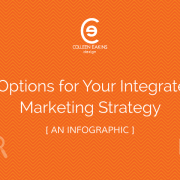Whether you are establishing a brand or updating one, don’t overlook the importance of using colors in graphic design to represent your organization.
Color theory and psychology date back to Egyptian times. Their observations and findings were that colors could affect people’s moods. In modern society, these same principles remain true.
By using colors in graphic design, you are setting the tone and building the foundation for your entire brand. Colors are subjective. Influences such as culture, other associations with the color, personal preferences, and additional factors impact how people perceive your brand just based on color!
Don’t forget, that hues and saturations can awaken distinct responses – either negative, positive, or neutral. Ideally, you want to choose a color that resonates with your product or service offering, audience, or customer base.
An Overview of What Colors Represent
Primary colors include red, blue, and yellow. When primary colors get combined, they create secondary colors. Secondary colors include orange; a combination of red and yellow; purple, a combination of red and blue; and green, a combination of blue and yellow.
Selecting a color that embodies your product or service plays a critical role in establishing your brand identity. Here are a few thoughts to consider when choosing the colors that represent your organization.
Subtle colors are more calming than harder colors on the spectrum. These softer colors, including purple, violet, and green, tend to not be as visible to people. Pastels and faded colors are harder to focus on, giving them a calming effect. Additionally, these soft shades and hues are believed to help boost concentration.
Hard colors, including orange, red, and yellow stand out, have higher visibility and make objects look more substantial and closer. They create a sense of excitability and responsiveness from a consumer standpoint.
The most calming color is blue. Additionally, blue is a color that helps build trust and loyalty. Blue is a preferred color for brands including Facebook, Twitter, Lowe’s, Skype, and Ford. From a color psychology standpoint, blue is said to be helpful for suppressing the appetite.
Pink stimulates the appetite. Further, it evokes femininity, the female gender, sensitivity, romance, and sweetness. Favorite brands that use the color pink include Barbie, Pink, Taco Bell, and Cosmopolitan.
Red, when used in restaurants, encourages patrons to eat more, eat quicker, and leave promptly. For these reasons, it should come as no surprise that the color red commonly gets used by fast food chains and other eateries as core parts of their branding elements. Further, when the color red gets used in casinos and bars, patrons tend to lose track of time.
Other common associations with the color red include sultriness, heat, confidence, and ambition.
Top brands that use the color red in their graphic design and branding elements include Walgreens, Coca-Cola, McDonald’s, KFC, Del Taco, Baja Fresh, Virgin Brands, and more.
The color yellow is cheerful. Not surprisingly, it is also the most visible and recognizable color. (Think about traffic signs!) Yellow is ideal for grabbing attention, projecting urgency, as well as spreading optimism and hope. Leading companies and brands that use yellow in their graphic design and branding elements include BestBuy, Subway, Sonic, IKEA, and Snapchat.
Orange is a color that conveys feelings of warmth, freedom, and optimism. Brands that use the color orange in their graphic design and branding campaigns include Blogger, Mastercard, The Home Depot, Firefox, Harley-Davidson, and Amazon. In marketing, the color orange is sometimes used to make expensive items appear less expensive, so could be worth considering if you’re offering a higher-end product or service to your client base.
Green is a color that represents growth, prosperity, generosity, and clarity. Other associations include health, positivity, and balance. If your product or service caters to wealthier clients, forest or other darker shades of green help you appeal to this target audience. Companies and organizations that implement the color green into their brand include BP, John Deere, Starbucks, Whole Foods, Holiday Inn, and Monster Energy Drinks.
If you want to project an air of luxury, respectability, and individuality, consider using purple as a significant element in your branding. Brands that use the color purple include Yahoo, Cadbury, Hallmark, Curves, and Aussie Haircare Products. All of these established brands have carved out a niche in their target demographic group.
White, inevitably, plays a role in graphic design. Whether it is serving as a backdrop for your website pages, white is integral in all clean, crisp, and fresh graphic design and branding elements.
On the opposite side of the spectrum, but equally important in graphic design, is the color black. Black often gets associated with sophistication, elegance, and simplicity. Brands that use black as a core component in their logos and other aspects of their graphic design include Coach, Chanel, Gucci, and Michael Kors.
It should come as no surprise that using black on white is the clearest and most comfortable for most people to read, printed on paper, or viewed using a monitor or handheld device. Since readability issues should always get considered during the design process, never overlook how keeping it simple can help move your brand ahead, just using clarity.


Don’t Be Afraid to Ask for Advice
If you are starting your business, the chances are good that you have a million details that need to get addressed! It’s OK to admit that you aren’t an expert in every aspect of your business model. If branding and graphic design isn’t your expertise, seeking the advice of professionals who specialize in this industry is a smart idea.
Additionally, we can assist established brands and organizations with all aspects of rebranding and enhancements to existing branded assets, including websites, graphic designs, printed materials, and other digital assets.
All you need to do is bring your concepts and let the team turn your vision into a reality. It’s that easy! Start the conversation by contacting the experts at Colleen Eakins Design today!
I’m a Digital Marketer & Freelance Writer with a penchant for all things forward-thinking and positive. I’m a fan of abundance and progress.



 ©2018, Colleen Eakins Design
©2018, Colleen Eakins Design
 ©2018, Colleen Eakins Design
©2018, Colleen Eakins Design ©2018, Colleen Eakins Design
©2018, Colleen Eakins Design ©2018, Colleen Eakins Design
©2018, Colleen Eakins Design